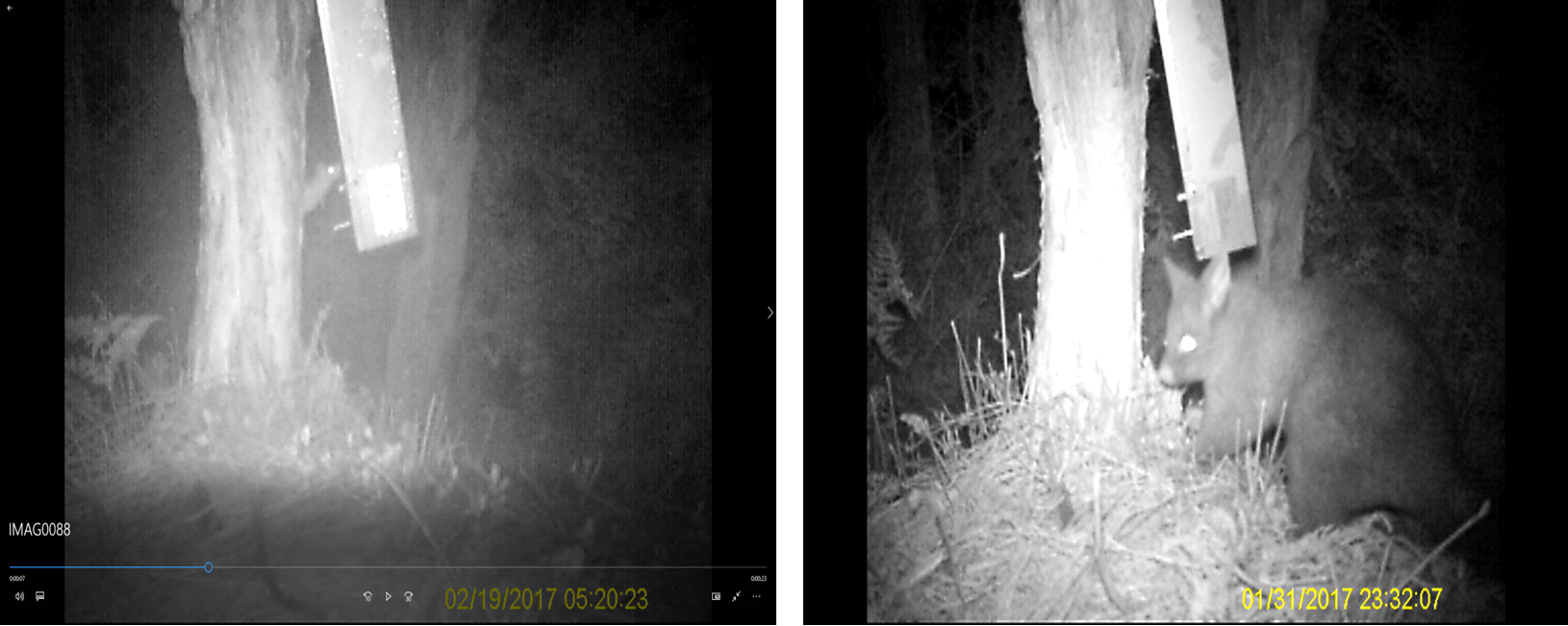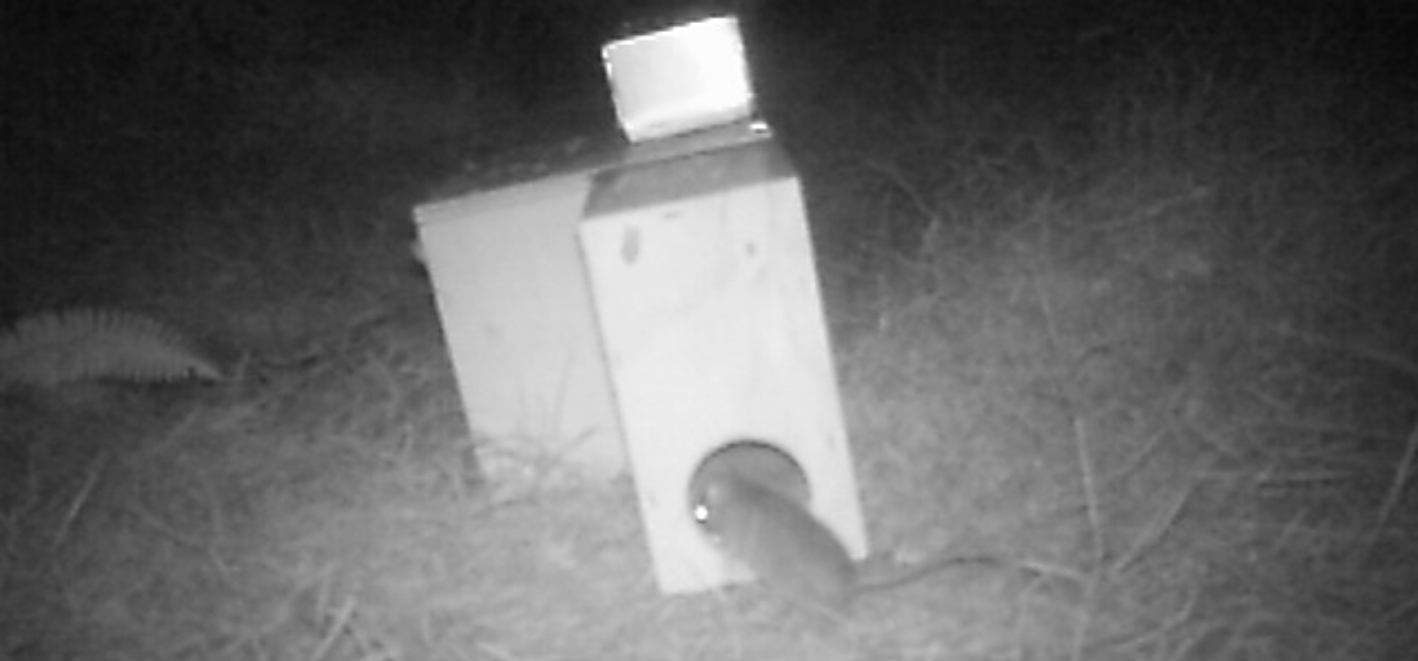Tim Sjoberg and Phil Bell – May 2018
This project was one of a suite of projects carried out during 2015-2017, with funding from six New Zealand dairy companies: Fonterra, Tatua, Synlait, Westland Milk Products, Open Country Dairy and Miraka.
INTRODUCTION/BACKGROUND
Luring target predators to control devices is critical in effective predator control. Without a suitable lure to encourage pest animals to encounter and then interact with a control device, many animals will simply walk past traps thereby reducing the effectiveness of the predator control device (Sam, 2011). Traditionally, lures used for predator control include peanut butter for rats, cinnamon flour blaze for possums, and rabbit meat for stoats. However proven these lures are, their freshness and durability in the field is limited due to mould growth, consumption by non-target species (e.g. weka, waxeyes, or mice) or simply being washed away in wet weather. Typically, lures need to be manually refreshed by the trapper every 3-4 weeks. These constraints have driven the development of an automated food lure dispenser.
An automatic lure dispenser is expected to bring three major benefits to predator control, i.e.: (i) reduce the labour and associated costs with ‘refreshing’ current lures; (ii) maintain the freshness of lure that is being stored, by preventing mould growth and lure decay, and (iii) permanently maintain lure in the control device (even if nontargets remove the previous lure).
Another potential benefit of an automatic lure dispenser is anticipated to be the ability to pre-feed animals, thereby habituating them onto desirable lures before they encounter a control device. Pre-feeding is expected to increase the effectiveness of the presented trap because animals have already been exposed to a perceived ‘safe’ food within a non-threatening environment. Pre-feeding is commonly used in predator control to ‘cue’ pest animals onto a desirable taste before a toxin or traps are set for the first time.
OBJECTIVE
The objective of this programme was to produce an automated lure dispenser able to dispense highly desirable ‘fresh’ food-based lures for rats, possums and stoats for a minimum of one year throughout a wide range of temperature and climatic environments. Unit costs needed to be under $50 each and be designed to easily attach and service when mounted either horizontally (e.g. on the top of a trap box) or vertically (e.g. onto a tree when pre-feeding).
DESIGN PROCESS
Infact, a Christchurch based mechanical and engineering company, and ZIP entered a joint development agreement in early 2016 and began work on the automatic lure dispenser concept design. Much of the initial research involved characterising lures with respect to their viscosity at different temperatures, separation over time, and how the lures responded to extrusion under force.
By April 2016, Infact had identified and tested desirable lure characteristics and produced prototypes able to extrude known volumes (0.15ml) of lure at predetermined time intervals (Figure 1.). Early prototypes investigated the use of pivot systems driven by a set of springs which forced the syringe plunger down when a proprietary gearbox and motor drive turned a lead screw, releasing the spring energy in staged increments. The prototypes were software controlled giving precise control over the time of dispensing the lure.
Figure 1. Early prototype testing of the viscosity of Nutella when extruded via a plastic syringe under pressure.
Forecast unit costs of the productionised version of lure dispenser (based on that prototype) were considered too high to be viable. This led to a re-work of the design during the early part of 2017. The lure dispenser prototype was ‘stripped down’, noncritical components were removed, and the size and weight of the lure dispenser housing were reduced to produce a final design.
The automated lure dispenser extrudes 0.15 ml of lure each night, triggered by a sensor within the motor driver housing; the volume and timing can be programmed as desired. When activated, the drive shaft screws a plunger down within a standard (and therefore cheap) medical syringe, filled with lure, thus forcing the lure to be extruded from the bottom of the dispenser.
The motor unit is powered by battery, with a life of 10 years (when dispensing once a day). The timing, for use by ZIP, is pre-programmed to extrude lure at nightly intervals to reduce the removal of bait by non-target species, and to maximise access for rats and possums when they are most active.
The unit cost of this ‘slimmed down’ lure dispenser was forecast as being within the desired range, and therefore we progressed to tooling parts for the manufacture of the components and completing the final laboratory and field test trials.
RESULTS
Three manufacture quality units of the lure dispenser underwent testing.
One underwent extensive laboratory assessment under extreme low and high temperature, humidity, and prolonged salt spray testing in order to hasten corrosion and seek product weakness. Testing found no faults or areas of concern.
The other two units were assessed under field conditions at our Marlborough Sounds study site. One of the lure dispensers was vertically mounted onto a tree acting as a pre-feed device (as in the above photograph); while the other was horizontally attached to a TUN200 trap. Both lure dispensers recorded no observed faults during their time in the field (which exceeded three months).
Camera evidence (see below) indicated that the dispenser was operating as intended, and both rats and possums repeatedly visited it to remove the extruded lure at night. Importantly, no damage by rats or possums was recorded or observed on the automatic lure dispensers (indicating they are ‘chew proof’).
Figure 3: Both rats (left) and possums (right) have been recorded consuming the extruded lure during the night from the tree mounted automated lure dispenser (at Bottle Rock Peninsula).
Figure 4. The TUN200 with prototype automated lure dispenser (attached to the roof) has been attracting rats into the trap box to investigate the extruded lure.
DISCUSSION
The automated lure dispenser is capable of extruding 0.15 ml of highly desirable lure each night for one whole year without servicing. This volume of lure is considered sufficient to attract both rats and possums on nightly intervals. The extended time interval between lure syringe replacement (12 months) and the decade long lifespan of the motor driver (in a single use per day regime) mean this device will dramatically reduce the labour burden in servicing the traps, both in the immediate term and through its ‘whole of life’ time period.
We intend to set the device to dispense that quantity of lure approx. one hour after dark, to avoid non-target animals accessing it (e.g. birds during the day) before these predators are active (as they are both nocturnal). Servicing of automated lure dispensers will be a simple task. Simply loosen the cover lock wing nut, remove the cover, wind back the lead screw with a power drill and replace the old empty lure syringe with a new syringe (and close the unit up again).
Given the highly geared nature of the motor that drives the syringe plunger, any semisolid or liquid lure can be used – thus it is a multi-purpose device based on which lure is used to attract which predator(s).
Tools to mould all the plastic parts have been manufactured in China, and used to manufacture a prototype run of 130 units (also in China). Those initial units have been installed at ZIP’s Perth Valley field site as part of a bio-marker trial.
There has been considerable interest already in this lure dispenser from the wider conservation community in NZ, especially in light of its utility for all kinds of traps. The production tools have since been shipped to New Zealand where long-term manufacture and assembly will take place. ZIP is in the process of securing manufacturing and retail supply agreements with NZ companies to provide the outlet for others to purchase the lure dispenser. A final market price has not been identified yet. ZIP has no profit motive and will therefore set this price point to ensure accessibility for the conservation industry here.
ACKNOWLEDGEMENTS
Infact and all the ZIP staff have played a key role in the development, technical input and both laboratory and field testing. A special thank you to the ZIP team at Lincoln for their help and support during the animal behaviour and functionality testing.
REFERENCES
Sam S. 2011. New monitoring and control tools for simultaneously managing possums, rats and mice in New Zealand.


